Apple
Apple Debuts Retail Stores
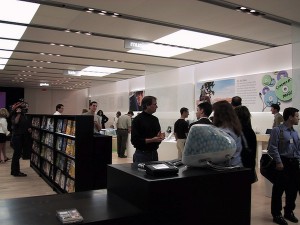 May 19, 2001
May 19, 2001
Apple Computer opens the first two locations of their new retail stores in McLean, Virginia and Washington, D.C. In the first weekend of opening, the stores will attract 7,700 shoppers and will sell a combined $599,000. While ridiculed by many technology “experts” at the time, the Apple Stores have been insanely successful and was one of the key reasons for Apple’s resurgence in the 2000’s.
Apple III Introduced
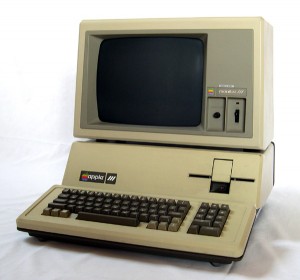 May 19, 1980
May 19, 1980
At the National Computer Conference in Anaheim, California, Apple Computer introduces the Apple III. It is the company’s first attempt at a business computer, its first departure from the Apple II architecture, and it will also become Apple’s first real failure. Apple expects the Apple III to be released in July, but in one of the worst cases of delay in tech history, the system wouldn’t reach stores until January. Once released, the Apple III will be plagued by component failures that would ultimately lead to large recalls. The Apple III never recovered from it’s original negative reception and was discontinued by Apple in 1984
Apple Retail Stores Revealed
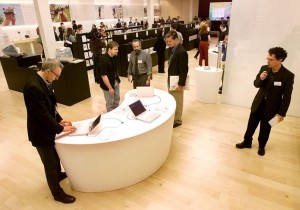 May 15, 2001
May 15, 2001
Apple Computer announces plans to operate a chain of retail stores, opening twenty-five retail stores in the United States by the end of the year. Steve Jobs holds a commemorative press event at Apple’s first store in the second level of Tysons Corner Center to make the announcement. The store, along with a second location in Washington, D.C. will open on Saturday, May 19. At the time, Apple’s plan was generally derided by technology “experts” as doomed to failure. On this, their anniversary date, Apple’s retail stores are now considered one of the catalysts to Apple’s tremendous growth.
System 7 Released
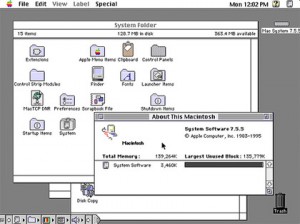 May 13, 1991
May 13, 1991
The System 7 operating system for the Macintosh is released, the second major upgrade to the Mac OS since 1984. One of the major features included in System 7 is built-in cooperative multitasking. System 7 also introduces the concept of “aliases”, which will later be copied as “shortcuts” in Microsoft Windows 95. System 7 was the first Mac OS that I personally became familiar with, and it was the foundation of future Mac OS versions until the release of Mac OS X almost exactly 10 years later.
“i” is for Apple
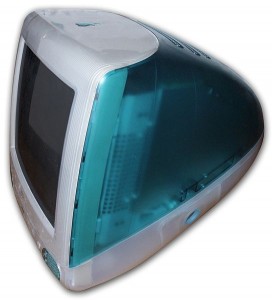 May 6, 1998
May 6, 1998
At the Flint Center Theater, the same place where the Macintosh was first unveiled in 1984, Steve Jobs introduces the original iMac. This iMac was later referred to as the “Bondi Blue”, after the color of its case (named for a beach in Australia). According to Jobs, the iMac is “the Internet-age computer for the rest of us.” By reimagining and reintroducing the simplicity of the all-in-one computer that was the hallmark of the original Macintosh 14 years earlier, Apple was banking on the ease-of-use of the iMac to attract many people to the Macintosh platform who wanted to make use of the still emerging Internet. Originally slated to be available in ninety days, it will actually be released on August 15th. In the meantime, Apple will book an unprecedented 150,000 orders before its release, marking the beginning of Apple’s renaissance. With its colorful design, the iMac ended the trend of the beige personal computer and even influenced the design of products outside the computer industry. It also ushered in the era of Apple adding the letter “i” to just about every product it created for a time. But hey, Apple eventually became the world’s most valuable company, so who’s arguing?
I remember helping my uncle buy an original iMac at a computer store in St. Louis (I think it was CompUSA but I don’t remember for certain now). I believe there were only a total of 15 iMacs for sale so we had to get there early to make sure we got one when they officially went on sale. There was a lot of fanfare and excitement in the air. I knew this was a big deal for Apple at the time, but little did I know exactly just how important an event this was in technology history. Plus I was a little jealous of my uncle for being able to get an iMac but at least I would be able to experience it when helping him set it up.
iTunes Music Store Launched; Record Execs Wet Themselves
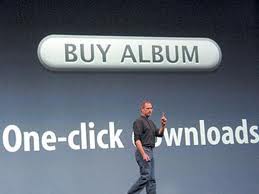 April 28, 2003
April 28, 2003
Apple Computer launches the iTunes Music Store. The store sells music for 99¢ a song for use with the Apple iPod and iTunes software. It is not the first service to sell digital music, but it will become the first to gain widespread popularity. The service will be an instant success, selling over one million songs in its first week and going on to change the music industry forever. The iTunes Music Store is now the #1 music retailer in the United States, surpassing Wal-Mart in 2008.
A Crazy Day for Apple
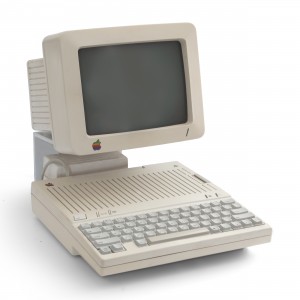 April 24, 1984
April 24, 1984
On the same day in 1984, Apple introduces the Apple IIc computer, announces Mac sales numbers, and discontinues the Apple III line.
The Apple IIc was Apple’s first attempt at a portable computer. Dealers place orders for more than 52,000 units on the first day. Apple also announces that over 60,000 Macs have been sold since their introduction in January that year. In contrast, the Apple III line only sold an estimated 120,000 units in the four years since it was introduced, losing Apple about $60 million dollars.
PC Industry Born
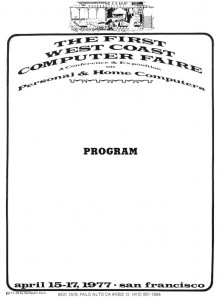 April 15, 1977
April 15, 1977
The first annual West Coast Computer Faire is held over three days in San Francisco, California, attended by 12,750 people. The Faire features the debut of the Apple II computer, which features 16KB of memory, BASIC, a built-in keyboard, eight expansion slots, and built-in high-resolution color graphics. Many credit this event and the launch of the Apple II as giving birth to the personal computer industry.
Who in the World is Ronald Wayne?
 April 12, 1976
April 12, 1976
Ronald Wayne, one of the three co-founders of Apple Computer, leaves the company just eleven days after it was established, selling his ten percent share for $800. In his short time with the company, Wayne illustrated the first Apple logo, wrote the company’s partnership agreement, and wrote the manual for the Apple I. He choose to leave the company because the partnership agreement imposed unlimited personal liability on all three co-founders, regardless of which partner incurred the debt. Unlike Jobs and Wozniak, 21 and 25, Wayne had personal assets that potential creditors could seize. The failure of a slot machine company he had started five years earlier also contributed to his decision to exit the partnership. Wayne would later say that, “Either I was going to be bankrupt or the richest man in the cemetery.” By 1982, a ten percent share of Apple Computer was worth US$1.5 billion. And in 2010 it was worth $22 billion. They say hindsight is 20/20 … or perhaps $22 billion?
Sculley Forces Out Jobs
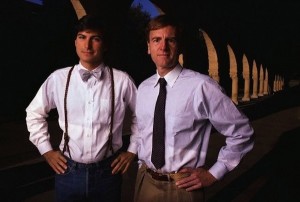 April 11, 1985
April 11, 1985
Almost exactly 2 years after joining Apple, John Sculley, asks Steve Jobs to step down as head of the Macintosh division at an Apple Computer board meeting. With the backing of the company’s other executives, Jobs is stripped of nearly all responsibilities at Apple. While Jobs retains the title of Chairman, he has no authority and eventually leaves Apple.
